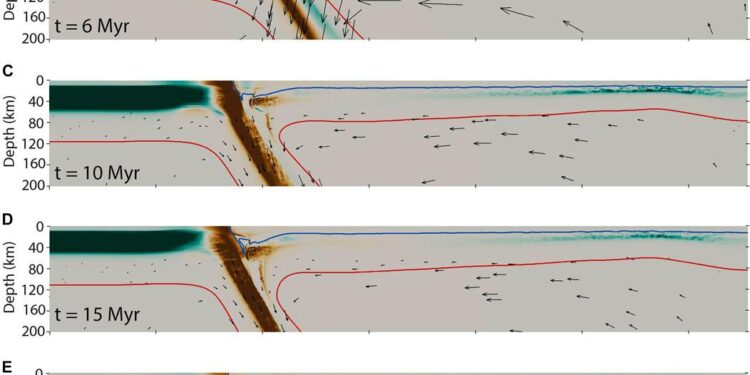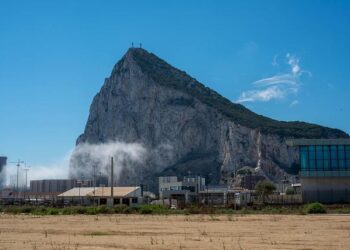A groundbreaking study published in Nature sheds new light on the tectonic forces shaping the western Mediterranean region. Researchers have uncovered compelling evidence for the upright emplacement of the Gibraltar slab-a key geological feature whose positioning may hold the answers to the mysterious origins of rifting in nearby foreland and backarc basins. This discovery not only challenges previous models of regional tectonics but also offers fresh insights into the complex interactions driving basin formation along convergent plate margins. Scientists say these findings could reshape our understanding of how mountain-building processes influence the evolution of surrounding basins, with significant implications for geology and natural resource exploration.
Upright Gibraltar Slab Sheds Light on Tectonic Dynamics in Mediterranean Region
The recent study reveals a groundbreaking perspective on the vertical positioning of the Gibraltar slab beneath the Mediterranean basin. Unlike the traditionally assumed horizontal subduction, researchers have identified an upright slab emplacement that fundamentally alters our understanding of regional tectonic forces. This discovery is crucial in explaining the genesis of rifting phenomena observed in both adjacent foreland and backarc basins, offering new clarity on the processes driving basin evolution.
Key implications of the upright slab configuration include:
- Tectonic rearrangement influencing extensional stresses across the Gibraltar Arc region.
- Initiation of rift basins primarily through vertical slab rollback mechanisms rather than simple lateral subduction.
- Enhanced seismic activity due to heightened slab-mantle interactions at depth.
- Revised models for Mediterranean lithospheric deformation, affecting regional hazard assessments and resource exploration.
| Feature | Traditional Model | New Findings |
|---|---|---|
| Slab Orientation | Horizontal to gently dipping | Upright vertical |
| Rifting Origin | Lateral extension along plate boundary | Vertical rollback-induced extension |
| Seismic Implications | Moderate-depth earthquakes | Deep and complex seismicity |
Exploring the Role of Slab Emplacement in Triggering Rift Formation in Foreland and Backarc Basins
Recent geophysical investigations reveal that the upright emplacement of the Gibraltar slab plays a pivotal role in the tectonic dynamics of the region, fundamentally influencing the formation of rift structures within both foreland and backarc basins. This vertical slab orientation induces localized extensional stresses, which act as a catalyst for rifting by promoting lithospheric thinning and fault reactivation. Crucially, the process diverges from traditional slab rollback mechanisms, instead highlighting a complex interplay between slab geometry and plate boundary forces that governs basin evolution.
Key factors linked to slab emplacement and rift initiation include:
- Vertical slab penetration: Concentrates strain accumulation beneath the overriding plate.
- Stress partitioning: Facilitates simultaneous compression in the foreland and extension in the backarc area.
- Thermal anomalies: Enhances mantle upwelling, weakening the lithosphere and encouraging rifting.
| Parameter | Effect on Rifting |
|---|---|
| Slab Dip Angle | Controls strain localization |
| Mantle Temperature | Influences lithosphere weakening |
| Convergence Rate | Modulates stress transmission |
Experts Call for Integrated Geological Surveys to Enhance Understanding of Regional Rift Evolution
Recent studies have emphasized the critical need for a synergistic approach combining seismic imaging, geochemical analysis, and tectonic modeling to unravel the complexities of rift evolution in areas adjacent to the Gibraltar slab. Experts argue that only through integrated geological surveys can the dynamic processes that governed the slab’s upright emplacement and the subsequent formation of foreland and backarc basins be fully understood. This multidisciplinary perspective enables researchers to link subsurface structures with surface deformation, shedding light on the chronological sequence of rifting events that shaped the regional geology.
Key components for advancing this integrated approach include:
- High-resolution seismic tomography to delineate crustal and lithospheric boundaries.
- Geochemical fingerprinting of basaltic flows within backarc basins.
- Structural mapping of fault systems related to the Gibraltar slab tectonics.
- Numerical modeling to simulate stress distributions during slab uplift and basin development.
| Survey Element | Geological Feature | Expected Insight |
|---|---|---|
| Seismic Imaging | Slab geometry | 3D slab morphology and fault interaction |
| Geochemistry | Volcanic deposits | Source region and magma evolution |
| Structural Analysis | Rift-related faults | Deformation timing and kinematics |
| Numerical Modeling | Tectonic stress | Mechanisms driving slab uplift and rifting |
Key Takeaways
The recent study on the upright emplacement of the Gibraltar slab sheds new light on the complex tectonic forces shaping the Mediterranean region. By unraveling the origins of rifting in both foreland and backarc basins adjacent to this unique geological feature, scientists are piecing together a clearer picture of Earth’s dynamic crustal movements. These findings not only deepen our understanding of regional geology but also have broader implications for studying rift formation and plate interactions worldwide. As research continues, the Gibraltar slab promises to remain a focal point in the quest to decode the planet’s ever-changing landscape.
















